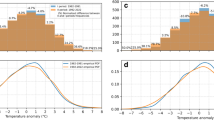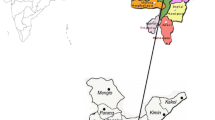Abstract
Uncertainty analysis of radar rainfall enables stakeholders and users have a clear knowledge of the possible uncertainty associated with the rainfall products. Long-term empirical modeling of the relationship between radar and gauge measurements is an efficient and practical method to describe the radar rainfall uncertainty. However, complicated variation of synoptic conditions makes the radar-rainfall uncertainty model based on historical data hard to extend in the future state. A promising solution is to integrate synoptic regimes with the empirical model and explore the impact of individual synoptic regimes on radar rainfall uncertainty. This study is an attempt to introduce season, one of the most important synoptic factor, into the radar rainfall uncertainty model and proposes a seasonal ensemble generator for radar rainfall using copula and autoregressive model. We firstly analyze the histograms of rainfall-weighted temperature, the radar-gauge relationships, and Box and Whisker plots in different seasons and conclude that the radar rainfall uncertainty has strong seasonal dependence. Then a seasonal ensemble generator is designed and implemented in a UK catchment under a temperate maritime climate, which can fully model marginal distribution, spatial dependence, temporal dependence and seasonal dependence of radar rainfall uncertainty. To test its performance, 12 typical rainfall events (4 for each season) are chosen to generate ensemble rainfall values. In each time step, 500 ensemble members are produced and the values of 5th to 95th percentiles are used to derive the uncertainty bands. Except several outliers, the uncertainty bands encompass the observed gauge rainfall quite well. The parameters of the ensemble generator vary considerably for each season, indicating the seasonal ensemble generator reflects the impact of seasons on radar rainfall uncertainty. This study is an attempt to simultaneously consider four key features of radar rainfall uncertainty and future study will investigate their impacts on the outputs of hydrological models with radar rainfall as input or initial conditions.









Similar content being viewed by others
References
AghaKouchak A, Bárdossy A, Habib E (2010a) Conditional simulation of remotely sensed rainfall data using a non-Gaussian v-transformed copula. Adv Water Resour 33:624–634
AghaKouchak A, Bárdossy A, Habib E (2010b) Copula-based uncertainty modelling: application to multisensor precipitation estimates. Hydrol Process 24:2111–2124
Anagnostou EN, Krajewski WF, Seo D-J, Johnson ER (1998) Mean-field rainfall bias studies for WSR-88D. J Hydrol Eng 3:149–159
Anagnostou MN, Anagnostou EN, Vivekanandan J (2006) Correction for rain path specific and differential attenuation of X-band dual-polarization observations. IEEE Trans Geosci Remote Sens 44:2470–2480
Berne A, Delrieu G, Andrieu H (2005) Estimating the vertical structure of intense Mediterranean precipitation using two X-band weather radar systems. J Atmos Ocean Technol 22:1656–1675
Bringi V, Rico-Ramirez M, Thurai M (2011) Rainfall estimation with an operational polarimetric c-band radar in the United Kingdom: comparison with a gauge network and error analysis. J Hydrometeorol 12:935–954
Campos E, Zawadzki I, Petitdidier M, Fernandez W (2006) Measurement of raindrop size distributions in tropical rain at Costa Rica. J Hydrol 328:98–109
Ciach GJ, Krajewski WF (1999) On the estimation of radar rainfall error variance. Adv Water Resour 22:585–595
Ciach GJ, Krajewski WF, Villarini G (2007) Product-error-driven uncertainty model for probabilistic quantitative precipitation estimation with NEXRAD data. J Hydrometeorol 8:1325–1347
Cluckie I, Griffith R, Lane A, Tilford K (2000) Radar hydrometeorology using a vertically pointing radar. Hydrol Earth Syst Sci Dis 4:565–580
Collier CG (1989) Applications of weather radar systems. Ellis Horwood, Chichester
Dai Q, Han D, Rico-Ramirez M, Srivastava PK (2014) Multivariate distributed ensemble generator: a new scheme for ensemble radar precipitation estimation over temperate maritime climate. J Hydrol 511:17–27
Germann U, Galli G, Boscacci M, Bolliger M (2006) Radar precipitation measurement in a mountainous region. Quart J R Meteorol Soc 132:1669–1692
Germann U, Berenguer M, Sempere-Torres D, Zappa M (2009) REAL—Ensemble radar precipitation estimation for hydrology in a mountainous region. Quart J R Meteorol Soc 135:445–456
Godambe V (1960) An optimum property of regular maximum likelihood estimation. Ann Math Stat 31:1208–1211
Godambe V (1976) Conditional likelihood and unconditional optimum estimating equations. Biometrika 63:277–284
Götzinger J, Bárdossy A (2008) Generic error model for calibration and uncertainty estimation of hydrological models. Water Resour Res 44:W00B01
Habib E, Qin L (2011) Application of a radar-rainfall uncertainty model to the NWS multi-sensor precipitation estimator products. Meteorol Appl 20(3):276–286
Habib E, Ciach GJ, Krajewski WF (2004) A method for filtering out raingauge representativeness errors from the verification distributions of radar and raingauge rainfall. Adv Water Resour 27:967–980
Habib E, Aduvala AV, Meselhe EA (2008) Analysis of radar-rainfall error characteristics and implications for streamflow simulation uncertainty. Hydrol Sci J 53:568–587
Joe H (1997) Multivariate models and dependence concepts. CRC Press, Boca Raton
Jordan P, Seed A, Austin G (2000) Sampling errors in radar estimates of rainfall. J Geophys Res Atmos (1984–2012) 105:2247–2257
Kavetski D, Kuczera G, Franks SW (2006a) Bayesian analysis of input uncertainty in hydrological modeling: 1. Theory. Water Resour Res 42
Kavetski D, Kuczera G, Franks SW (2006b) Bayesian analysis of input uncertainty in hydrological modeling: 2. Application. Water Resour Res 42
Kitchen M, Brown R, Davies A (1994) Real-time correction of weather radar data for the effects of bright band, range and orographic growth in widespread precipitation. Quart J R Meteorol Soc 120:1231–1254
Lack SA, Fox NI (2005) Errors in surface rainfall rates retrieved from radar due to wind-drift. Atmos Sci Lett 6:71–77
Lack SA, Fox NI (2007) An examination of the effect of wind-drift on radar-derived surface rainfall estimations. Atmos Res 85:217–229
Lauri T, Koistinen J, Moisseev D (2012) Advection-based adjustment of radar measurements. Mon Weather Rev 140(3):1014–1022
Michelson DB, Sunhede D (2004) Spurious weather radar echo identification and removal using multisource temperature information. Meteorol Appl 11:1–14
Moore R, Jones D, Cox D, Isham V (2000) Design of the HYREX raingauge network. Hydrol Earth Syst Sci Dis 4:521–530
Pamment J, Conway B (1998) Objective identification of echoes due to anomalous propagation in weather radar data. J Atmos Ocean Technol 15:98–113
Priestley M (1981) Spectral analysis and time series. Academic Press, London
Reichert P, Mieleitner J (2009) Analyzing input and structural uncertainty of nonlinear dynamic models with stochastic, time-dependent parameters. Water Resour Res 45
Rico-Ramirez M, Cluckie I (2007) Bright-band detection from radar vertical reflectivity profiles. Int J Remote Sens 28:4013–4025
Seo D-J, Breidenbach J (2002) Real-time correction of spatially nonuniform bias in radar rainfall data using rain gauge measurements. J Hydrometeorol 3:93–111
Seo D-J, Breidenbach J, Johnson E (1999) Real-time estimation of mean field bias in radar rainfall data. J Hydrol 223:131–147
Seo D-J, Breidenbach J, Fulton R, Miller D, O’Bannon T (2000) Real-time adjustment of range-dependent biases in WSR-88D rainfall estimates due to nonuniform vertical profile of reflectivity. J Hydrometeorol 1:222–240
Smith JA, Krajewski WF (1991) Estimation of the mean field bias of radar rainfall estimates. J Appl Meteorol 30:397–412
Smith JA, Krajewski WF (1993) A modeling study of rainfall rate-reflectivity relationships. Water Resour Res 29:2505–2514
Steiner M, Smith JA (2002) Use of three-dimensional reflectivity structure for automated detection and removal of nonprecipitating echoes in radar data. J Atmos Ocean Technol 19:673–686
Uijlenhoet R, Berne A (2008) Stochastic simulation experiment to assess radar rainfall retrieval uncertainties associated with attenuation and its correction. Hydrol Earth Syst Sci 12:587–601
Ulbrich CW, Atlas D (2002) On the separation of tropical convective and stratiform rains. J Appl Meteorol 41:188–195
Villarini G, Krajewski WF (2009) Empirically based modelling of radar-rainfall uncertainties for a C-band radar at different time-scales. Quart J R Meteorol Soc 135:1424–1438
Villarini G, Krajewski WF (2010) Review of the different sources of uncertainty in single polarization radar-based estimates of rainfall. Surv Geophys 31:107–129
Villarini G, Mandapaka PV, Krajewski WF, Moore RJ (2008a) Rainfall and sampling uncertainties: a rain gauge perspective. J Geophys Res Atmos (1984–2012) 113
Villarini G, Serinaldi F, Krajewski WF (2008b) Modeling radar-rainfall estimation uncertainties using parametric and non-parametric approaches. Adv Water Resour 31:1674–1686
Westrick KJ, Mass CF, Colle BA (1999) The limitations of the WSR-88D radar network for quantitative precipitation measurement over the coastal western United States. Bull Am Meteorol Soc 80:2289–2298
Wilson JW, Brandes EA (1979) Radar measurement of rainfall-A summary. Bull Am Meteorol Soc 60:1048–1058
Wood S, Jones D, Moore R (2000) Static and dynamic calibration of radar data for hydrological use. Hydrol Earth Syst Sci Dis 4:545–554
Xu JJ (1996) Statistical modelling and inference for multivariate and longitudinal discrete response data. PhD dissertation, University of British Columbia, Vancouver
Acknowledgments
The first author would like to thank the University of Bristol and China Scholarship Council for providing the necessary support and funding for his PhD research. The authors acknowledge the British Atmospheric Data Centre for providing the data.
Author information
Authors and Affiliations
Corresponding author
Rights and permissions
About this article
Cite this article
Dai, Q., Han, D., Zhuo, L. et al. Seasonal ensemble generator for radar rainfall using copula and autoregressive model. Stoch Environ Res Risk Assess 30, 27–38 (2016). https://doi.org/10.1007/s00477-014-1017-x
Published:
Issue Date:
DOI: https://doi.org/10.1007/s00477-014-1017-x




